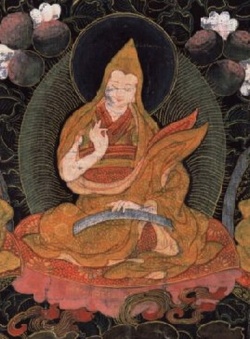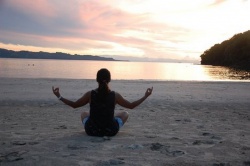Drubkhang Gelek Gyatso
Drubkhang Gelek Gyatso (grub khang dge legs rgya mtsho) was born in a poor family in Zanskar (zangs dkar) in Ladakh in 1641, the iron-snake year of eleventh sexagenary cycle in 1641.
His father, was called Guru Konchok (gu ru dkon mchog) and his mother was named Bumochok (bu mo mchog). He was called Mikza (dmig za) in his childhood. His father died when he was six years old and his mother suffered from tuberculosis, forcing him to spend his youth nursing her; while serving her he learned reading and recitation of prayers texts at home. When Gelek Gyatso reached at seventeen his mother died. He completed the funeral and cremation rites and rituals as per the local Buddhist tradition.
Soon thereafter young Migza travelled to Jampa Ling Monastery in Tibet and received the vows of upasaka from Lobpon Lobzang Lekpa (slon dpon blo bzang legs pa, d.u.) and studied there for about two years. He then travelled to U-Tsang for further studies, and on his way he had audience of the Fourth Paṇchen Lama Lobzang Chokyi Gyeltsen (paN chen bla ma 04 blo bzang chos kyi rgyal mtshan, 1570-1662) in Tashilhunpo. He then proceeded to [[Shang] Gotsang]] (shangs rgod tshang) and received his novice ordination from Drungpa Tsondu Gyeltsen (drung pa brtson 'grus rgyal mtshan, d.u.), who gave him the name Gelek Gyatso.
After spending a short period at Sera, following the recommendation from Drungpa Tsondu Gyeltsen, Gelek Gyatso enrolled in Dakpo Monastery (dwags po grwa tshang) and studied under the tutorship of Jetsun Lodro Tenpa (rje brtsun blo gros brtan pa d.u.) and Lhading Lobzang Dondup (lha sdings blo bzang don grub, d.u.); and also many other scholars at the monastery. He studied the traditional texts for sixteen years starting with the primary dialectical topics and logic followed by the traditional courses in Pranamavartika, Abhisamayālaṅkāra, Madhyamaka, Vinaya, and Abhidharmakosha.
The administration of Dakpo sought to appoint him to the post of disciplinarian (dge bskos), but Gelek Gyatso refused, leaving the monastery rather than accept the post. He returned to study with Drungpa Tsondu Gyeltsen in Gotsang and he received the vows of full ordination.
He also received empowerment, transmission, and commentarial teachings on Lamrim, the [[Wensa Nyengyu (dben sa snyan brgyud), Ganden Mahāmudrā (dga' ldan phyag chen), Six Dharmas of Naropa (nA ro chos drug) and so forth from Tapukpa Lobzang Damcho Gyeltsen (rta phug pa blo bzang dam chos rgyal mtshan, b. 1595/1607). Drungpa Tsondu Gyeltsen instructed Gelek Gyatso to return to Dakpo and properly apply to leave the monastery, which he did, and was officially relieved after giving a commentarial teaching to the monks on Tsongkhapa's Differentiation of the Interpretable and the Definitive; (drang nges rnam 'byed).
Following Drungpa Tsondu Gyeltsen's death, Gelek Gyatso received teachings at Tashilhunpo from Tapukpa and the Mongolian lama Kachen Lobzang Dondup (hor dka' chen blo bzang don grub, d.u.) who were disciples of the late Drungpa. He also received teachings from many other lamas including Lama Rinchen Dondup (bla mamrin chenmdon grub), Rego Acarya (re sgo a tsa ra), Zhal-nga Chopel Gyatso (zhal snga chos 'phel rgya mtsho, d.u.) and others. He also received many teachings, transmissions, esoteric instructions, and empowerment relating to Chod from Lobpon Jampa Choden (slob dpon byams pa chos ldan, d.u.) and other tantric teachers.
Gelek Gyatso remained for a time in Tashilhunpo and then proceeded to Lhasa and met the abbot of Sera Je, Joten Sonam Gyeltsen (se ra byes mkhan po jo stan bsod nams rgyal mtshan, d.u.) who showed him a meditation center (sgrub khang) in the mountains behind the Sera Monastery and recommended he stay there.
He resided at the center until he was about fifty years old, leaving Sera some time after 1692. He traveled to Olkha ('ol kha), Gyel (rgyal), Dakpo (dwags po), Tsari (tsa ri), and many more places for pilgrimage as an itinerant lama.
In 1705 Gelek Gyatso returned to Sera and established the first of his three hermitages above Sera at Sera Utse (se ra dbu rtse), with a capacity for about seventeenth monks.
At the site was a retreat hut occupied first by Tsongkhapa who did a retreat there; Gelek Gyatso was advised to practice there by his teacher, the Sera abbot Joten Sonam Gyeltsen.
At a cave at Purchok named Dochung Chongzhi (rdo cung cong zhi) he built a temple of the deities of the three families (rigs gsum mgon po’i lha khang), which he later expanded to a hermitage named Purbuchok (phur lcog sgrub khang).
The cave was said to have been a practice site of Padmasambhava, and the site where the Tsalpa Kagyu founder ]]Zhangdrowa Gonpo Yudrakpa\\ (]]zhang 'gro ba'i mgon po g.yu brag pa]], 1123-1193) later established a practice center. The third hermitage was Rakadrak (ra kha brag), for twelve monks.
To administer these three hermitages he composed the Drubde Constitution (sgrub sde'i bca' yig). Presumably it was after the establishment of these three hermitages, or Drubkhang (sgrub khang) that he came to be known as Drubkhang Gelek Gyatso.
Among Drubkhang Gelek Gyatso's many disciples the most prominant was Purchok Ngawang Jampa (phur lcog ngag dbang byams pa, 1682-1762) from Chamdo, whom he appears to have met first in 1699 and to whom he entrusted the Purchok hermitage. Other disciples included Khardo Zopa Gyatso (mkhar rdo bzod pa rgya mtsho, 1672-1749), the founder of Khardo Hermitage near Purchok; Ngawang Chokden, an abbot of Gyume College (rgyud smad mkhan po nga dbang mchog ldan, d.u.); the Forty-Ninth Ganden Tripa, Trichen Lobzang Dargye ([[dga' ldan] khri rabs 49 co ne blo bzang dar rgyas]], 1662-1723); and the Twenty-fifth abbot of Kumbum, Ngawang Tenpa (sku 'bum khri 25 ngag dbang bstan pa, 1683-1746).
He composed a text entitled “[[Drang ba dang nges pa'i don rnam par 'byed pa'i bstan bcos legs par bshad pa'i snyin po'i dgongs pa'i don gsal bar [byed pa'i me long]]”. He also wrote Drubde Constitution (sgrub sde'i bca' yig) for the three practice centers founded by him. According to sources he also composed a Gurma (mgur ma), a poetic religious song.
Drubkhang Gelek Gyatso passed into nirvana in the water-snake year of the twelfth sexagenary cycle in 1713 at the age of seventy-three.
Sources
Cabezón, José Ignacio. 2006. The Hermitages of Sera. Charlottesville: The Tibetan and Himalayan Digital Library, pp. 13-15;
Don rdor and bstan 'dzin chos grags. 1993. Gangs ljongs lo rgyus thog gig rags can mi sna. Lhasa: Bod ljongs mi dmangs dpe skrun khang, pp. 682-684.
Grags pa 'byungs gnas and Blo bzang mkhas grub. 1992. Gangs can mkhas sgrub rim byon ming mdzod. Lanzhou: Kan su'u mi rigs dpe skrun khang, pp. 426-427.
Ye shes rgyal mtshan. 198?. Rje sgrub khang pa dge legs rgya mtsho'i rnam thar. In Lam rim bla ma brgyud pa'i rnam thar, vol. 2, pp. 284-302. 'Bar khams: Rnga khul bod yig rtsom sgyur cus. Also published in 1990 in Lhasa by the Bod ljongs mi dmangs dpe skrun khang, pp. 657-671.
Samten Chhosphel September 2010

